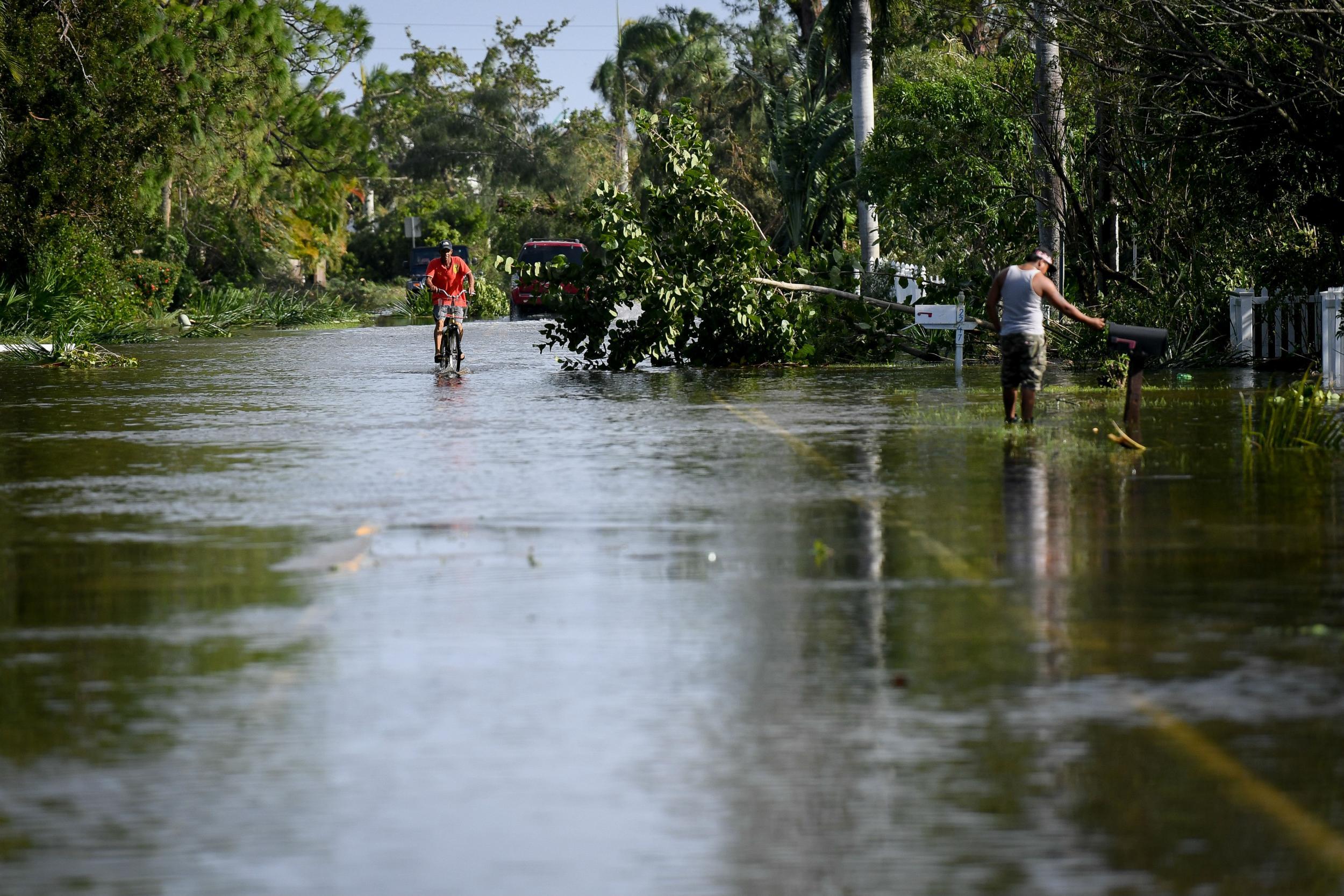Rubble, power outages, and sunshine: What life is like after Irma for Florida’s returning residents
The state was largely spared from the disaster that had been predicted

Florida woke up to blazing sunshine just a day after Hurricane Irma descended upon the state with devastating rain and winds that reached upwards of 120 mph, tearing trees and road signs to the ground, flooding streets, and damaging homes in its path.
Whatever sense of normalcy the rising sun may seem to bring, though, is deceptive.
The state was largely spared from the devastation that experts believed to be on the way, but many Floridians are still tasked with waiting out the lingering effects of a major hurricane making landfall here, and with beginning the process of rebuilding and cleaning up.
Power, water, and gas, can still be tough to come by across the state. There are still about 13 million people without power as of Sunday night, according to estimates. Doing business without power is tricky, and long lines form outside of the few shops that manage to open their doors. At gas stations with petrol to sell, lines stretch down the street.
Irma battered Florida Sunday, killing at least 11 people across Florida, South Carolina and Georgia - with that number expected to change - and sending storm surges of more than 10 feet into parts of the coast. The storm forced just under 7 million people to evacuate their communities, fearing that they could be trapped in their homes or worse if they stayed. Cell service from Miami out west was sparse, and communicating was difficult. In the Florida Keys, where Irma initially made landfall in the US, about 25 per cent of the buildings there have been damaged, according to an official, and roughly 65 per cent of the homes were significantly damaged. In Miami, areas of downtown were flooded, and mobile phone service was sparse for many there looking to get in touch with family or loved ones.
Local authorities told around 90,000 residents of Miami Beach and people from some parts of the Keys they could go home but warned it might not be prudent to remain there.
“This is going to be a frustrating event. It's going to take some time to let people back into their homes particularly in the Florida Keys,” Brock Long, administrator of the Federal Emergency Management Agency (FEMA), said.
Millions of people were still without power in Florida.
But, still, some Floridians refused skip a beat, even if an incredibly strong storm had just visited.
Sami Rahmir opened up his restaurant in Marco Island at 10am Monday, offering up hot chicken sandwiches, tacos, ice, and drinks to locals. Inside his restaurant — which looked like something of a triage station for food — Mr Rahmir hurried about to pack orders, addressing many of his customers by name.
“The way I look at it, every moment, we’re alive,” Mr Rahmir, who said he couldn’t get much sleep over the previous three days because he was horrified about the apocalyptic predictions for Irma on TV, said.
In both Naples and Marco Island, debris could be seen everywhere. Palm fronds were hardly the worst of it: Broken branches, toppled street signs, and entire felled trees made many streets impassible. Firemen crisscrossed Naples with chainsaws dismembering the larger branches; bulldozers smashed through accumulated debris and trees to clear roads.
While most buildings appeared to have avoided major damage in the area, some were completely torn apart. A petrol station between Naples and Marco Island was toppled during the storm, leaving behind splintered white metal where supports cracked. In the nearby Riverwood Estates, a 55 and older community, walls and roofs were completely removed from mobile homes.
“It was rough. It was, really, nothing I would’ve ever expected,” Dawn Byington, who lives in Marco Island, said.
Ms Byington said she stayed in town for the storm — where it directly hit — and that her home had sustained roof damage, her boat was damaged, and that her air conditioning was hit. “I have to just get everything fixed, and go back to enjoying Marco,” she said.
“It looks worse than it is,” Julie Bryant said of the damage to her home in Marco Island. She and her family had waited out the storm in Fort Meyer, and were pleasantly surprised to see that their home was mostly in tact when they returned. They’re still without power, and their boat is propped nearly vertical from the wind, but they still expect a full recovery.
The city of Jacksonville, in Florida's northeast was also was recovering from heavy flooding.
“There are so many areas that you would never have thought would have flooded that have flooded,” Florida Governor Rick Scott said after a helicopter tour of the area.
All told, estimates indicate that Irma could cost roughly $49.5 billion, a dramatic drop from initial estimates that pegged the figure at around $150 billion. Still, that amounts to a pretty steep natural disaster check for the US, after Hurricane Harvey inundated Houston and southeastern Texas with floods. Harvey is expected to cost between $65 and $75 billion.
As the outside world argues those figures, though, people stuck without power have different concerns. People waiting in hotels for word on their homes debate how quickly power might go back on, and which utilities are given priority. They exchange tips on where you might find gas, and they try to lend expertise to trouble shoot internet problems that seem to be plaguing the few places with power.
And, with that power still out in much of the surrounding region, first responders continue clear safe paths, and police lights can be seen at intersections where officers have been dispatched to direct traffic where lights are still down.
Join our commenting forum
Join thought-provoking conversations, follow other Independent readers and see their replies
Comments